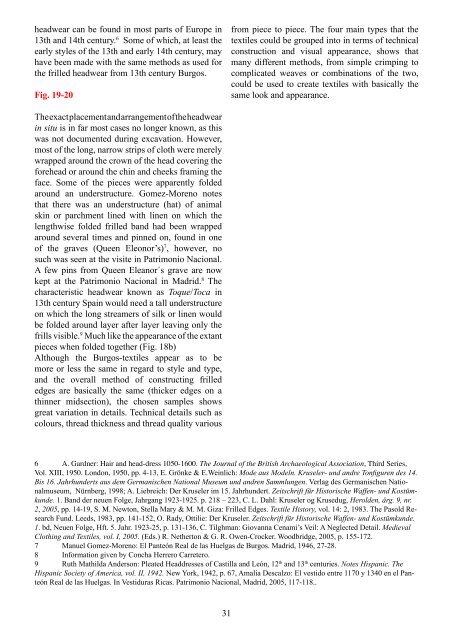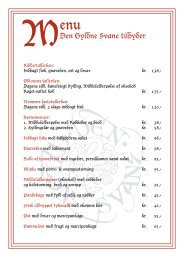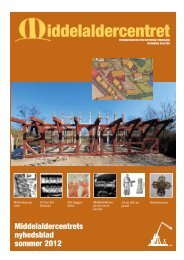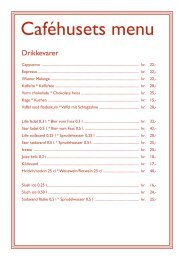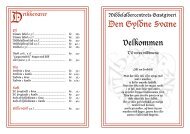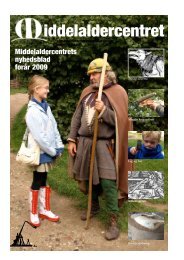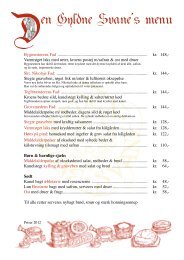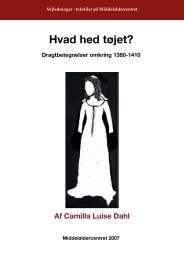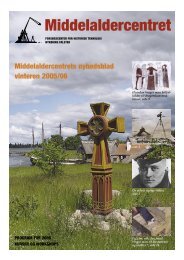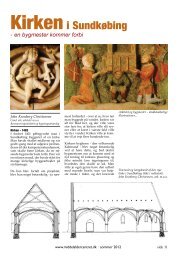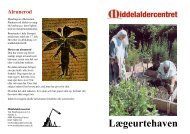Report on the Textiles from Burgos Cathedral - Middelalder Centret
Report on the Textiles from Burgos Cathedral - Middelalder Centret
Report on the Textiles from Burgos Cathedral - Middelalder Centret
Create successful ePaper yourself
Turn your PDF publications into a flip-book with our unique Google optimized e-Paper software.
headwear can be found in most parts of Europe in<br />
13th and 14th century. 6 Some of which, at least <strong>the</strong><br />
early styles of <strong>the</strong> 13th and early 14th century, may<br />
have been made with <strong>the</strong> same methods as used for<br />
<strong>the</strong> frilled headwear <strong>from</strong> 13th century <strong>Burgos</strong>.<br />
Fig. 19-20<br />
The exact placement and arrangement of <strong>the</strong> headwear<br />
in situ is in far most cases no l<strong>on</strong>ger known, as this<br />
was not documented during excavati<strong>on</strong>. However,<br />
most of <strong>the</strong> l<strong>on</strong>g, narrow strips of cloth were merely<br />
wrapped around <strong>the</strong> crown of <strong>the</strong> head covering <strong>the</strong><br />
forehead or around <strong>the</strong> chin and cheeks framing <strong>the</strong><br />
face. Some of <strong>the</strong> pieces were apparently folded<br />
around an understructure. Gomez-Moreno notes<br />
that <strong>the</strong>re was an understructure (hat) of animal<br />
skin or parchment lined with linen <strong>on</strong> which <strong>the</strong><br />
lengthwise folded frilled band had been wrapped<br />
around several times and pinned <strong>on</strong>, found in <strong>on</strong>e<br />
of <strong>the</strong> graves (Queen Ele<strong>on</strong>or’s) 7 , however, no<br />
such was seen at <strong>the</strong> visite in Patrim<strong>on</strong>io Naci<strong>on</strong>al.<br />
A few pins <strong>from</strong> Queen Eleanor´s grave are now<br />
kept at <strong>the</strong> Patrim<strong>on</strong>io Naci<strong>on</strong>al in Madrid. 8 The<br />
characteristic headwear known as Toque/Toca in<br />
13th century Spain would need a tall understructure<br />
<strong>on</strong> which <strong>the</strong> l<strong>on</strong>g streamers of silk or linen would<br />
be folded around layer after layer leaving <strong>on</strong>ly <strong>the</strong><br />
frills visible. 9 Much like <strong>the</strong> appearance of <strong>the</strong> extant<br />
pieces when folded toge<strong>the</strong>r (Fig. 18b)<br />
Although <strong>the</strong> <strong>Burgos</strong>-textiles appear as to be<br />
more or less <strong>the</strong> same in regard to style and type,<br />
and <strong>the</strong> overall method of c<strong>on</strong>structing frilled<br />
edges are basically <strong>the</strong> same (thicker edges <strong>on</strong> a<br />
thinner midsecti<strong>on</strong>), <strong>the</strong> chosen samples shows<br />
great variati<strong>on</strong> in details. Technical details such as<br />
colours, thread thickness and thread quality various<br />
31<br />
<strong>from</strong> piece to piece. The four main types that <strong>the</strong><br />
textiles could be grouped into in terms of technical<br />
c<strong>on</strong>structi<strong>on</strong> and visual appearance, shows that<br />
many different methods, <strong>from</strong> simple crimping to<br />
complicated weaves or combinati<strong>on</strong>s of <strong>the</strong> two,<br />
could be used to create textiles with basically <strong>the</strong><br />
same look and appearance.<br />
6 A. Gardner: Hair and head-dress 1050-1600. The Journal of <strong>the</strong> British Archaeological Associati<strong>on</strong>, Third Series,<br />
Vol. XIII, 1950. L<strong>on</strong>d<strong>on</strong>, 1950, pp. 4-13, E. Grönke & E.Weinlich: Mode aus Modeln. Kruseler- und andre T<strong>on</strong>figuren des 14.<br />
Bis 16. Jahrhunderts aus dem Germanischen Nati<strong>on</strong>al Museum und andren Sammlungen. Verlag des Germanischen Nati<strong>on</strong>almuseum,<br />
Nürnberg, 1998; A. Liebreich: Der Kruseler im 15. Jahrhundert. Zeitschrift für Historische Waffen- und Kostümkunde.<br />
1. Band der neuen Folge, Jahrgang 1923-1925. p. 218 – 223, C. L. Dahl: Kruseler og Krusedug, Herolden, årg. 9, nr.<br />
2, 2005, pp. 14-19, S. M. Newt<strong>on</strong>, Stella Mary & M. M. Giza: Frilled Edges. Textile History, vol. 14: 2, 1983. The Pasold Research<br />
Fund. Leeds, 1983, pp. 141-152, O. Rady, Ottilie: Der Kruseler. Zeitschrift für Historische Waffen- und Kostümkunde.<br />
1. bd, Neuen Folge, Hft. 5. Jahr. 1923-25, p. 131-136, C. Tilghman: Giovanna Cenami’s Veil: A Neglected Detail. Medieval<br />
Clothing and <strong>Textiles</strong>, vol. I, 2005. (Eds.) R. Ne<strong>the</strong>rt<strong>on</strong> & G. R. Owen-Crocker. Woodbridge, 2005, p. 155-172.<br />
7 Manuel Gomez-Moreno: El Panteón Real de las Huelgas de <strong>Burgos</strong>. Madrid, 1946, 27-28.<br />
8 Informati<strong>on</strong> given by C<strong>on</strong>cha Herrero Carretero.<br />
9 Ruth Mathilda Anders<strong>on</strong>: Pleated Headdresses of Castilla and León, 12 th and 13 th centuries. Notes Hispanic. The<br />
Hispanic Society of America, vol. II, 1942. New York, 1942, p. 67, Amalia Descalzo: El vestido entre 1170 y 1340 en el Panteón<br />
Real de las Huelgas. In Vestiduras Ricas. Patrim<strong>on</strong>io Naci<strong>on</strong>al, Madrid, 2005, 117-118..


